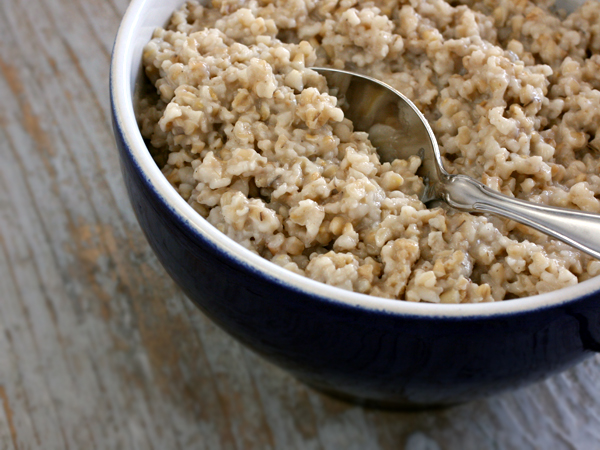You’ve learned about what to eat to meet your health and body composition goals. But what about when you eat it?
What is nutrient timing?
Nutrient timing is a planned alteration of macronutrient intake in order to promote health, workout performance, and get/stay lean.
Nutrient timing strategies are based on how the body handles different types of food at different times. One of the most important nutrient timing principles is that it’s best to eat most non-fruit and veggie carbohydrates during and after exercise.
Many factors influence energy balance, with the laws of thermodynamics being the most important determinants of weight gain and weight loss. Yes, this means how much we eat is priority #1 when changing body composition.
But the key here is “body composition.” If we’re losing equal amounts of fat and muscle when losing weight or gaining equal amounts of fat and muscle when gaining weight, we’re not taking advantage of nutrient timing.
Nutrient timing has several important goals:
- Nutrient partitioning (where the nutrients go when you ingest them)
- Improved health
- Improved body composition
- Improved athletic performance
- Enhanced workout recovery
Why is nutrient timing so important?
When you exercise regularly, the body is primed for fat gain or fat loss just as it’s primed for muscle gain or muscle loss during specific times of the day. The wrong foods at the wrong times sabotage your efforts in the gym. The right foods at the right times enhance those efforts.
Once we account for energy balance, timing nutrient intake can up-regulate metabolism, shift hormonal profile, and alter body composition.
Manipulating nutrient intake can also help someone take advantage of certain anabolic hormones, namely insulin.
Insulin
Insulin regulates nutrient entry into muscle cells. If insulin is seldom elevated, the muscle growth related benefits won’t occur. If you plan a higher carbohydrate intake at times when your body is better equipped to handle it, insulin will be under your control, and the body will function better.
Carbohydrate use
The body handles various types of carbohydrates differently. Generally, carbohydrates that are digested and absorbed slowly can help to control insulin response. These are carbohydrates that are higher in fibre and lower in simple sugars, such as beans/legumes and vegetables.
In contrast, a diet consisting of added sugars and refined carbohydrates (which enter the body rapidly), can elevate blood triglyceride levels and bad cholesterol, and lead to insulin resistance.
The raw materials we give our body through the consumption of food/supplements create the metabolic environment we desire.
What you should know
Regardless of goals and activity, protein and fat intake stay fairly constant. Make sure, as per PN habits, that you consume an appropriately sized portion of lean protein and good fats with every meal. The macronutrient we manipulate most commonly in nutrient timing is carbohydrate.
Carbohydrate tolerance and timing
The body can better handle carbohydrates during and after physical activity, as well as when levels of fitness are high and body fat levels are lower (15% or less for men and 20% or less for women).
Therefore, higher-carb situations include some combination of:
- relatively intense physical activity (such as heavy resistance training or sprinting)
- relatively frequent physical activity (daily workouts, physically active job, lots of daily-life activity such as walking)
- a high level of physical fitness
- a lower level of body fat
Conversely, lower-carb situations include some combination of:
- sedentary or nonactive periods
- lower levels of physical fitness
- higher levels of body fat
For more on this, see the Eating For Your Body Type video and All About Eating for Your Body Type.
Regardless of your body fat and fitness, consuming carbohydrate during this important postworkout period enables us to replace muscle glycogen and improve recovery. Like a sponge, we draw in all that tasty glycogen much more readily immediately after training.
When to consume carbs
After exercise, keep the recovery process moving by controlling carb intake and consuming plenty of protein rich foods.
Dense carb foods are best consumed during and after exercise, for up to about 3 hours. And remember, carbohydrates have a protein sparing effect, so we require less dietary protein when carb intake is higher.
Before you break out your sun watch and start meticulously timing carb gram intake, the window here depends on many factors, including:
- Intensity of exercise
- Previously fasted/fed
- Body composition
- Medications
- Underlying health conditions
- Sleep schedule
- Length of exercise
- Type of exercise
- Food selection
- Time of day
With so many factors, it’s hard to say exactly how long carb tolerance stays high after exercise. For most folks, though, assume that carb tolerance is best for approximately 3 hours after exercise. If you sleep 8 hours per night, then factor in this 3 hour post-workout window, you’re left with about 13 hours of “non sponge-like carb tolerance” living, or 2 to 4 meals.
During the “non sponge-like” period, it’s important to adapt your food intake to what you tolerate. If you are lean and maintaining your current body composition, you’ll likely do fine with some dense carb foods mixed in (25% of your meal or so). If you have fat to lose, focus more on proteins and fats (with dense carb foods making up less than 25% of your meal).
Types of carbs
To put this in perspective, consider the three main types of carb foods:
1. Fiber-rich carbs
This includes vegetables, fruits and legumes. These foods are absorbed slowly because of their high fiber content and will thus help control blood sugar and hunger. These foods are loaded with nutrients, promote health and are “calorie-dilute”.
Having these foods at the base of your “food pyramid” is a great idea. Eat them anytime.

2. Starchy carbs
Quinoa, amaranth, sprouted grain breads, potatoes, yams, acorn squash, oats, sprouted grain pasta, cereals, and similar foods are very dense sources of carbs. They are a bit lower in nutrients than the fiber-rich carb foods.
These types of starchy carbs are best consumed after exercise. During this time, your muscles are like a big sponge and will use the carbs efficiently. Consume these starchy carbs during the 3 hours or so after exercise.
Remember, energy balance is still important: Keep portion size moderate. Generally a serving is about the size of your fist. That’s a good place to start.
Note: Outside of the 3 hour post-workout window, having a 1/4 cup of sweet potato or wild rice for dinner isn’t going to be a huge carb load for the body to deal with. If you can meet your compliance goals and keep good eating habits with small amounts of starchy carbs, then go ahead.
But be aware: the slope can get slippery. 1/4 cup can turn into a big bowl with added butter, which might mean overeating and no fat loss 3 weeks later. Use a strategy that works for you.

3. Refined sugary carbs
If you want to know what foods fall under this category, just follow around most American youth. The majority of these foods are empty calories and don’t do much for health.
Still, eating them during and immediately after exercise may give your body a quick energy boost and accelerate recovery.
Even then, consider the big picture: what is the food going to do for your health? What other substances are in it?
You could take advantage of refined sugary carb foods by using nutrient dense sources like dates, raisins, figs and nutrition bars. Don’t assume that because you exercised, you can eat as many refined sugary foods as you want.
Eat sugary carbs rarely, and only after exercise.

The best time to eat carbs
Consult the chart below to find out when to eat each of the three main types of carb foods.
| Carb type | Examples | When to eat |
| Fiber-rich | Vegetables (e.g., broccoli, kale, spinach, carrots, tomatoes, celery, cucumber, zucchini, beets, bok choy, lettuce, collards, pumpkin, radish, onion, chard, watercress, etc.) Peas Beans Legumes Most fruits |
Eat often, and any time of day (especially for veggies) |
| Starchy | Sprouted grain breads Corn Sprouted grain pasta Yams/sweet potatoes Quinoa Amaranth Oats Long grain rices |
During the 3 hours or so after exercise |
| Refined sugary | Desserts Fruit juice Processed foods Soda Sports drinks Most commercial nutrition bars Dates, figs, raisins, dried fruits |
Eat rarely, and during the 3 hours after exercise. |
Anytime (AT) meals vs post-workout (PW) meals
In our Gourmet Nutrition cookbook and in the Precision Nutrition System, we’ve marked meals as either AT or PW.
Anytime (AT): As the name suggests, these can be eaten anytime of the day. They have little or no refined sugary carbs, and often fewer starchy carbs too. AT meals generally contain less than 25% dense carb foods.
Post-workout (PW): These meals are best eaten in the 3 hours or so after exercise. They contain more than 25% dense carb foods, and occasionally refined sugary carbs.
Sample anytime (AT) and post-workout (PW) meals
Check out the following examples of PW and AT meals. These are taken straight from the records of our most successful clients.
Anytime (AT) meals
1 scoop protein powder
1 serving greens powder
1 tbsp peanut butter
Handful mixed nuts
Omega-3 supplement
1/2 cup tri-coloured beans
1 tbsp olive oil
Large salad with seasoning
1/2 cup chopped turkey
Omega-3 supplement
2 free range eggs
1/2 cup black beans
1/2 cup swiss chard
1 cup total green onions, mushrooms, olives
1 oz cheese
Omega-3 supplement
Post-workout (PW) meals
1 cup pineapple or fresh strawberries
1 sprouted grain English muffin with nut butter
2 free range eggs
Omega-3 supplement
1 yam
1 cup black beans
½ cup mixed vegetables
Omega-3 supplement
1 cup oats
1 cup blueberries
1 scoop protein powder
1 serving greens powder
1/2 cup hemp milk
Omega-3 supplement
Nutrient timing for muscle gain
Those interested in gaining muscle need a calorie surplus. However, just grossly over-consuming calories regularly will probably result in fat gain.
Nutrient timing helps prioritize muscle gain over fat gain during a muscle gaining phase. Plan meals in accordance with your weekly schedule and create a temporary food surplus.
Summary and recommendations
Nutrient timing is an important strategy, but it’s not for everyone.
If you’re new to healthy eating, don’t worry about timing for now. Start by improving the overall quality of your food and incorporating the basic PN habits into your life. Once you build a foundation of nutritious eating, then consider adding the nutrient timing habit.
If you are lean and simply want to maintain your existing body composition, consuming more carbohydrates throughout the day will likely be fine.
If you want to lose body fat, first control overall food intake, then aim to consume a majority of carb dense foods during and after exercise sessions (for about 3 hours after). Outside of the 3 hour window consume primarily protein and fat, while consuming fewer carb dense foods (25% of less of meal made up of carb dense foods).
If you want to gain muscle, the nutrient timing principles are similar — simply add more calories overall.
In all cases: Assess your progress and adjust as necessary.
For extra credit
- Nutrient timing strategies aren’t useful for the average North American. Glucose tolerance and insulin sensitivity? I don’t think so. Let’s just taper donut intake first.
- Nutrient timing may help control leptin and ghrelin levels.
- Nutrient timing can maximize glycogen stores and improve workouts.
- Metabolic “up-regulation” doesn’t always scale directly with food intake and too much of any nutrient, regardless of timing, can result in body fat gains. Using nutrient timing while still eating too much food will result in fat gain.
- If you are physically active all day (e.g. bike to work, physically active job, walk at lunch, weights after work, etc.), then your sensitivity to carbs will likely be enhanced .
References
Click here to view the information sources referenced in this article.
If you’re a coach, or you want to be…
You can help people build sustainable nutrition and lifestyle habits that will significantly improve their physical and mental health—while you make a great living doing what you love. We'll show you how.
If you’d like to learn more, consider the PN Level 1 Nutrition Coaching Certification. (You can enroll now at a big discount.)

Share